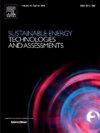改变太阳能玻璃表面粗糙度:一种被动减少污染的方法
IF 7.1
2区 工程技术
Q1 ENERGY & FUELS
Sustainable Energy Technologies and Assessments
Pub Date : 2025-07-10
DOI:10.1016/j.seta.2025.104447
引用次数: 0
摘要
太阳能光伏(PV)面板上的灰尘积聚或污染会大大降低发电效率。虽然通常采用主动清洁方法和防污涂层,但它们存在与水消耗、安装和维护成本相关的限制。本研究提出了一种简单、经济的化学蚀刻技术,通过改变太阳能玻璃的表面粗糙度来减少污染。样品在不同时间的酸性(HCl, 30, 120和180分钟)或碱性(NaOH, 30和120分钟)条件下蚀刻,并根据粗糙度参数和透射率损失评估其表面特征。采用控制污染室模拟室外粉尘沉积,评估表面覆盖和颗粒团聚。结果表明,具有负偏度的蚀刻表面(Ssk <;0)和近高斯峰度(Sku≈3)降低了污染。用KOH 12M蚀刻30分钟的太阳能玻璃在室内污染测试后,粉尘堆积减少了64.7%,透射率损失仅为13%,而在相同条件下,未经处理的玻璃减少了33%,防污和抗反射涂层玻璃减少了27%。这些结果表明,通过化学蚀刻来改善表面粗糙度是一种经济有效且易于实施的策略,可以减轻PV表面的污染。本文章由计算机程序翻译,如有差异,请以英文原文为准。
Modifying the surface roughness of solar glass: A passive mitigation method of soiling
Dust accumulation or soiling on solar photovoltaic (PV) panels significantly reduce power generation efficiency. While active claeaning methods and anti-soiling coatings are commonly employed, they present limitations related to water consumption, installation, and maintenance costs. This study presents a simple, cost-effective chemical etching technique to reduce soiling by modifying the surface roughness of solar glass. Samples were etched under acidic (HCl, 30, 120 and 180 min) or alkaline (NaOH, 30 and 120 min) conditions at different durations and their surface characteristics were evaluated in terms of roughness parameters and transmittance loss. A controlled soiling chamber was used to simulate outdoor dust deposition and assess surface coverage and particle agglomeration. The results showed that etched surfaces with negative skewness (Ssk < 0) and near-Gaussian kurtosis (Sku ≈ 3) reduced soiling. Solar glass etched with KOH 12M for 30 min exhibited a 64.7 % reduction in dust accumulation and only 13 % transmittance loss after indoor soiling tests, compared to 33 % in untreated glass and 27 % in anti-soiling and anti-reflective coated glass under the same conditions. These results demonstrate that surface roughness modification through chemical etching is a cost-effective and easily implementable strategy to mitigate soiling on PV surfaces.
求助全文
通过发布文献求助,成功后即可免费获取论文全文。
去求助
来源期刊

Sustainable Energy Technologies and Assessments
Energy-Renewable Energy, Sustainability and the Environment
CiteScore
12.70
自引率
12.50%
发文量
1091
期刊介绍:
Encouraging a transition to a sustainable energy future is imperative for our world. Technologies that enable this shift in various sectors like transportation, heating, and power systems are of utmost importance. Sustainable Energy Technologies and Assessments welcomes papers focusing on a range of aspects and levels of technological advancements in energy generation and utilization. The aim is to reduce the negative environmental impact associated with energy production and consumption, spanning from laboratory experiments to real-world applications in the commercial sector.
 求助内容:
求助内容: 应助结果提醒方式:
应助结果提醒方式:


